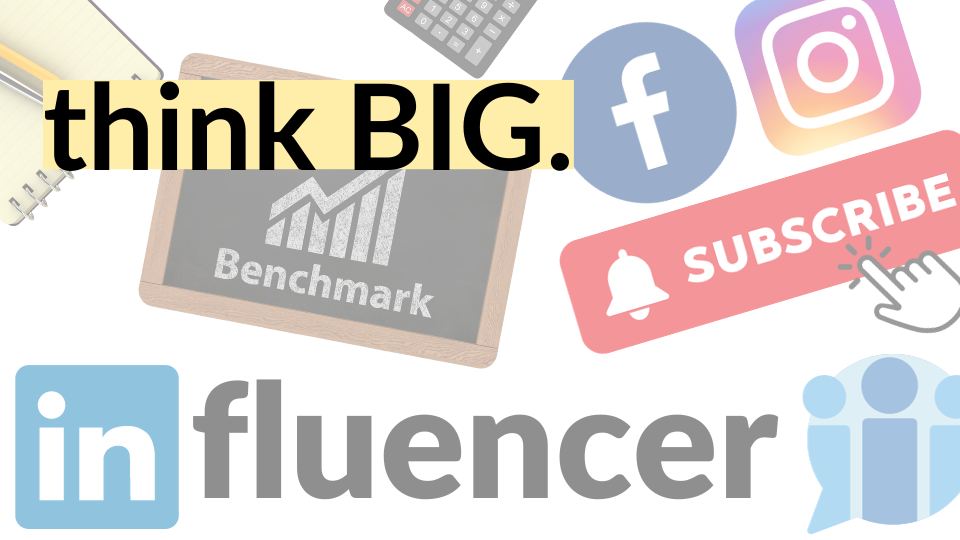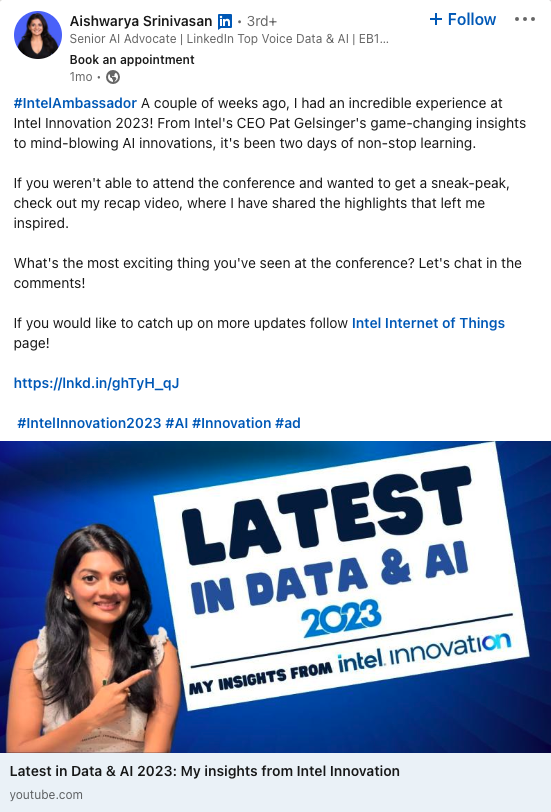TLDR:
- B2B influencers are gaining popularity. Why? Because they work.
- As ad-free social media tiers roll out, influencer partnerships will rise in importance and impact.
- Benchmarks to aid your 2024 planning. Tip: Look industry-wide and internally.
- 2023 Influencer Pay Equity Guide is now available.
Bold Brand Ideas: Intel and Hootsuite are making news with B2B influencers
Fast Company recently covered Intel, Teal, Zendesk and Hootsuite’s respective influencer campaigns on LinkedIn. The piece explores how B2B brands are tapping into a highly lucrative tactic historically used by DTC brands.
These successful campaigns followed the same best practices as consumer campaigns: right-fit partners + ongoing ambassadors, detailed briefs, attentiveness to trends and educational (vs. salesy) content.
It makes sense. Whether you’re a B2B or B2C marketer, you’re still marketing to people. But instead of trendsetters, you’re partnering with experts who have sway over opinions.
B2B journeys are complex and heavily influenced by word-of-mouth marketing. Plus, buyers aged 25-44 will make up 75% of business buying teams in 2024. And what do these professionals care about most? Expertise. Forrester predicts that in 2024, millennial buyers will rate engaging with experts as the most meaningful sales interaction. There is an opportunity for B2B brands who have been hesitant to pursue influencers to tap industry experts with a social following.
We’ve been executing B2B influencer campaigns since 2020 and can attest to the success. One client reported qualified leads within weeks, when on average, B2B campaigns see ROI after six months.
The key to this success is choosing the right partner who can help meet your business goals. B2B brands exploring influencers for the first time are often skeptical about finding the right partners for their campaign. But remember: your target is real people who trust other real people. Take a play out of B2C’s playbook and consider the following when vetting partners:
- Relevance – How will this influencer’s style and content represent [BRAND]?
- Reach – What relationship does the influencer have with their audience? Does the influencer’s audience reach [BRAND’S TARGET]?
- Resonance – How valuable is the content created by this influencer? Does the influencer’s audience positively receive recommendations?
- Risk – Do the influencer’s channels have obscene, vulgar or offensive content? Are their views polarizing or not aligned with [BRAND’S] values?
Curious about B2B influencers? Let’s talk.
Industry Insights: How will ad-free social media platforms impact influencer marketing?
Meta will now offer ad-free subscriptions on Instagram and Facebook in the EU, EEA and Switzerland. This new subscription was unveiled to comply with Europe’s evolving regulations and is not available for US users.
The subscription will cost around $17 a month (which is on par with ad-free streaming services). With that steep price tag, it’s unclear how widely adopted this version will be. It’s also unknown if this option will be introduced in other regions, but we can assume it might.

59% of marketers increased their influencer marketing budgets in 2023.
Still, this update and Europe’s regulations affect global brands’ paid strategies. Brands that rely heavily on social ads may need to shift their dollars to other lower-funnel tactics. For example, influencers may be a creative, effective and efficient workaround to this update – as the majority of brands already allocate spend to influencers. Specifically, 59% of marketers increased their influencer marketing budgets in 2023. The influencer industry currently stands at $21B, and investment is expected to drive social commerce sales of $2.6T (with a T) by 2026.
Influencers give brands the opportunity to reach audiences with authentic content – whether a consumer is on an ad-free subscription or not. But let’s be clear: we don’t recommend overly salesy or spammy influencer content. Influencer content should aim to educate or entertain customers, building affinity and interest for brands.
Goals: Benchmarking S.M.A.R.T. goals for 2024
‘Tis the season for annual planning and benchmarking. November is a great time to analyze this year’s work to inform next year’s S.M.A.R.T. (Specific, Measurable, Achievable, Relevant, and Time-Bound) goals.
It’s also a time to review industry averages and see how your brand stacks up. We recommend earmarking these resources:
- Hootsuite’s Average Social Media Engagement Rates Across Industries
- RivalIQ’s Social Media Benchmark Report
- Influencer Marketing Hub’s Social Media Marketing Benchmark Report
- Sprout Social’s Content Benchmarks Report
- MuckRack’s State of PR Measurement
We recently went through this exercise with a client in the travel + tourism industry. Our work together includes a mix of earned media, influencer relations, paid social and creative strategy. To help determine the most effective path forward, we compared this year’s results to industry standards and internal benchmarks. We asked questions like: How did this tactic stack up against other investments? How is our strategy performing compared to last year? What should we prioritize next year based on business goals and to optimize ROI?
We also looked at our KPIs along the sales funnel and how they compared to historical data and industry averages. For example:
- Awareness: In a year when earned media coverage was dependent on creative activations and strong storytelling, we saw a 5.88% YOY increase in placements.
- Consideration: Those media placements can be directly correlated to 8% of the destination’s website traffic from the year, contributing to a 161% YOY increase in web users. Earned media and influencer efforts also encouraged app downloads to explore the destination’s trails and events, resulting in a 136% YOY increase in app downloads.
- Action: We saw a 1.8% CTR across paid social ads on Facebook and Instagram, compared to the tourism industry average of .9%.
While we’re still in the midst of annual planning, we know one thing for sure: data and benchmarks must drive 2024 decisions.
Introducing, DEI Download.
Experts say DEI efforts have waned this year, despite their importance. Each month, we’ll share considerations for keeping inclusion top of mind in your marketing + communication efforts.
Recent studies indicate a 29% pay gap between white and BIPOC influencers – an unacceptable reality. In response, The Association of National Advertisers ( ANA) spearheaded a cross-industry initiative to develop the 2023 Influencer Pay Equity Guide.
The ANA convened the 4A’s, PR Council and marketers from major brands including Target, Bayer Consumer Health, Nationwide Insurance, Paramount, Wells Fargo and Unilever and key agency leaders – like Belle Communication! – to establish clear industry standards for equitable experiences that span across campaign planning and execution.

This report aims to create protocols in a historically unregulated arena, as legislation and sharing of industry best practices often lag in the influencer space. The impacts of this report will be especially important as influencers increasingly begin to be viewed as contract workers for brands.
Access ANA’s free guide here
Fill out the form below to be notified when our next blog publishes.





